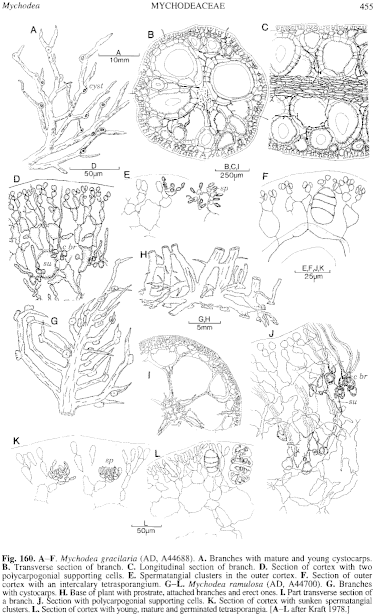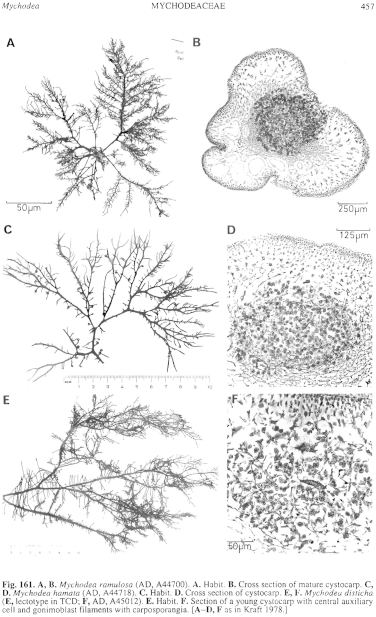|
|
|
|
|
|||||||||||
|
Electronic Flora of South Australia Species Fact Sheet
Phylum Rhodophyta – Class Florideophyceae – Order Gigartinales – Family Mychodeaceae
Selected citations: Kraft 1978: 538, figs 10, 11, 35. Kylin 1932: 63, fig. 19, pl. 26 fig. 64; 1956: 306, fig. 237A, B.
Thallus (Fig. 161A) light to dark red, clumped, 10–20 cm high, with several to numerous erect axes from a stoloniferous base (Fig. 160H); axes slightly to moderately compressed, 2–4 mm broad, with laterals mainly from the margins (Fig. 160G) but shorter laterals also from the surfaces, laterals terete to slightly compressed, with acute apices and not constricted basally. Holdfast consisting of stout haptera (Fig. 160H) 2–3 mm across on the stolons; epilithic or epiphytic on various larger algae, seagrasses or tunicates. Structure uniaxial, with a prominent apical cell, developing a lacunate outer medulla and small-celled cortex (Fig. 160I) similar to that in M. carnosa; outer cortical cells ovoid, 3–4 µm in diameter. Rhodoplasts elongate, ribbon like in inner cells.
Reproduction: Sexual thalli monoecious; procarpic; polycarpogonial. Carpogonial branches (Fig. 160J) 3-celled, 2–6 borne on inner cortical cells which become auxiliary cells producing gonimoblast filaments with short chains of ovoid carposporangia 15–24 µm in diameter, lying within the matrix of gametophytic and gonimoblast filaments (Fig. 161B); enveloping tissue slight, with a cortical depression outside the carposporophyte. Cystocarps protruding (Fig. 160G), hemispherical, with the adjacent ramulus bent. Spermatangia in scattered sunken clusters (Fig. 160K) in the outer cortex, similar to those in M. carnosa.
Tetrasporangia (Fig. 160L) scattered in the outer cortex, terminal, ovoid, 37–45 µm long and 20–25 µm in diameter, zonately divided.
Type from "Nov. Holl. occid. tum merid."; lectotype from Encounter Bay, S. Aust. (Hussey); in Herb. Agardh, LD, 33982.
Selected specimens: Albany, W. Aust., drift (Kraft, 11.xii.1971; AD, A44698). Esperance, W. Aust., drift (Firman, Dec. 1951; AD, A18908). Pearson Is, S. Aust., 5–12 m deep (Shepherd, 8.i.1969; AD, A34092). Wanna, S. Aust., drift (Womersley, 19.ii.1959; AD, A22380). Vivonne Bay, Kangaroo I., S. Aust., 2–6 m deep on jetty piles (Kraft, 6.iv.1972; AD, A44700). Pennington Bay, Kangaroo I., S. Aust., sublittoral fringe (Womersley, 7.i.1948; AD, A6683). Victor Harbor, S. Aust., drift (Womersley, 17.x.1948; AD, A9231). Whalers Point, Portland, Vic., drift (Muir, 17.i.1950; AD, A15739).
Distribution: King George Sound, W. Aust., to Portland, Vic.
Taxonomic notes: M. ramulosa is superficially similar to M. carnosa and M. disticha, differing from both in having a creeping stoloniferous base and ramuli which are bent sharply at the site of the cystocarps. It also differs from M. carnosa in having terminal tetrasporangia.
References:
AGARDH, J.G. (1897). Analecta Algologica. Cont. IV. Acta Univ. lund. 33, 1–106, Plates 1, 2.
KRAFT, G.T. (1978). Studies of marine algae in the lesser-known families of the Gigartinales (Rhodophyta). III. The Mychodeaceae and Mychodeophyllaceae. Aust. J. Bot. 26, 515–610.
KYLIN, H. (1932). Die Florideenordnung Gigartinales. Lunds Univ. Årsskr. N.F. Avd. 2, 28 (8), 1–88, Plates 1–28.
KYLIN, H. (1956). Die Gattungen der Rhodophyceen. (Gleerups: Lund.)
The Marine Benthic Flora of Southern Australia Part IIIA complete list of references.
Publication:
Womersley, H.B.S. (14 January, 1994)
The Marine Benthic Flora of Southern Australia
Rhodophyta. Part IIIA, Bangiophyceae and Florideophyceae (to Gigartinales)
Reproduced with permission from The Marine Benthic Flora of Southern Australia Part IIIA 1994, by H.B.S. Womersley. Australian Biological Resources Study, Canberra. Copyright Commonwealth of Australia.
Illustrations in Womersley Part IIIA, 1994: FIGS 160 G–L, 161A, B.

Figure 160 enlarge
Fig. 160. A–F. Mychodea gracilaria (AD, A44688). A. Branches with mature and young cystocarps. B. Transverse section of branch. C. Longitudinal section of branch. D. Section of cortex with two polycarpogonial supporting cells. E. Spermatangial clusters in the outer cortex. F. Section of outer cortex with an intercalary tetrasporangium. G–L. Mychodea ramulosa (AD, A44700). G. Branches with cystocarps. H. Base of plant with prostrate, attached branches and erect ones. I. Part transverse section of a branch. J. Section with polycarpogonial supporting cells. K. Section of cortex with sunken spermatangial clusters. L. Section of cortex with young, mature and germinated tetrasporangia. [A–L after Kraft 1978.]

Figure 161 enlarge
Fig. 161. A, B. Mychodea ramulosa (AD, A44700). A. Habit. B. Cross section of mature cystocarp. C, D. Mychodea hamata (AD, A44718). C. Habit. D. Cross section of cystocarp. E, F. Mychodea disticha (E, lectotype in TCD; F, AD, A45012). E. Habit. F. Section of a young cystocarp with central auxiliary cell and gonimoblast filaments with carposporangia. [A–D, F as in Kraft 1978.]

|
Email Contact: State Herbarium of South Australia |

|